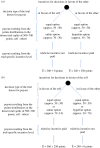Can monetary incentives overturn fairness-based decisions?
- PMID: 37351499
- PMCID: PMC10282581
- DOI: 10.1098/rsos.211983
Can monetary incentives overturn fairness-based decisions?
Abstract
Fairness norms and resulting behaviours are an important prerequisite for cooperation in human societies. At the same time, financial incentives are commonly used to motivate social behaviours, yet it remains unclear how financial incentives affect fairness-based behaviours. Combining a decision paradigm from behavioural economics with hierarchical drift-diffusion modelling, we investigated the effect of different financial incentives on two types of fairness-based decisions in four experimental groups. In two groups, participants divided points between themselves and a disadvantaged person, inciting fairness-based compensation behaviour, in two other groups they divided points between themselves and a fairness violator, inciting fairness-based punishment behaviour. In addition, each group received financial incentives that were either aligned or in conflict with the respective fairness-based behaviour. This design allowed us to directly investigate how different incentives shape the cognitive mechanism of fairness-based decisions and whether these effects are comparable across different fairness domains (fairness-based punishment versus fairness-based compensation). Results showed that offering conflicting incentives diminished fairness-congruent decision behaviour and rendered the fairness-congruent decision process less efficient. These findings demonstrate that financial incentives can undermine fairness-based behaviour, and thus are relevant for the development of incentive schemes aimed at fostering cooperative behaviour.
Keywords: compensation; drift-diffusion modelling; fairness; financial incentives; punishment.
© 2023 The Authors.
Conflict of interest statement
We declare we have no competing interests.
Figures







References
-
- Brasini M, Vecchio SD, Gregni E, Casali C, Mira F, Capuano N, Questa V, Giacomantonio M, Mancini F. 2018. Fairness is a more effective interpersonal motive than care for sustaining prosocial behaviour. Psychology 09, 1426-1443. (10.4236/psych.2018.96087) - DOI
-
- Camerer CF. 2011. Behavioral game theory: experiments in strategic interaction. Princeton, NJ: Princeton University Press.
-
- Fehr E, Schmidt KM. 1999. A theory of fairness, competition, and cooperation. Q. J. Econ. 114, 817-868. (10.1162/003355399556151) - DOI
-
- Bolton GE, Ockenfels A. 2000. ERC: a theory of equity, reciprocity, and competition. Am. Econ. Rev. 90, 166-193. (10.1257/aer.90.1.166) - DOI
LinkOut - more resources
Full Text Sources
